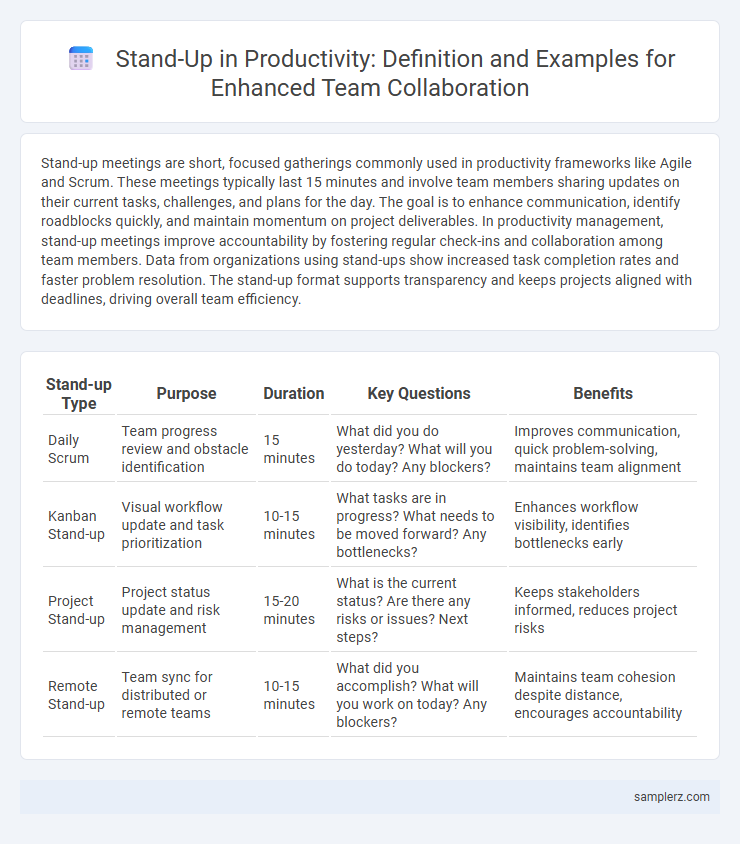Stand-up meetings are short, focused gatherings commonly used in productivity frameworks like Agile and Scrum. These meetings typically last 15 minutes and involve team members sharing updates on their current tasks, challenges, and plans for the day. The goal is to enhance communication, identify roadblocks quickly, and maintain momentum on project deliverables. In productivity management, stand-up meetings improve accountability by fostering regular check-ins and collaboration among team members. Data from organizations using stand-ups show increased task completion rates and faster problem resolution. The stand-up format supports transparency and keeps projects aligned with deadlines, driving overall team efficiency.
Table of Comparison
| Stand-up Type | Purpose | Duration | Key Questions | Benefits |
|---|---|---|---|---|
| Daily Scrum | Team progress review and obstacle identification | 15 minutes | What did you do yesterday? What will you do today? Any blockers? | Improves communication, quick problem-solving, maintains team alignment |
| Kanban Stand-up | Visual workflow update and task prioritization | 10-15 minutes | What tasks are in progress? What needs to be moved forward? Any bottlenecks? | Enhances workflow visibility, identifies bottlenecks early |
| Project Stand-up | Project status update and risk management | 15-20 minutes | What is the current status? Are there any risks or issues? Next steps? | Keeps stakeholders informed, reduces project risks |
| Remote Stand-up | Team sync for distributed or remote teams | 10-15 minutes | What did you accomplish? What will you work on today? Any blockers? | Maintains team cohesion despite distance, encourages accountability |
What Is a Stand-Up Meeting in Productivity?
A stand-up meeting in productivity is a short, focused gathering where team members quickly share updates, progress, and obstacles to maintain alignment and momentum. Typically lasting 10-15 minutes, these meetings encourage concise communication while promoting accountability and collaboration. By keeping the team informed, stand-ups help identify bottlenecks early and ensure efficient project advancement.
Key Benefits of Daily Stand-Ups for Teams
Daily stand-ups enhance team productivity by fostering clear communication and accountability, ensuring every member aligns on priorities and progress. These brief meetings accelerate problem-solving by quickly identifying obstacles, reducing delays in project timelines. Teams experience improved collaboration and morale, driving sustained focus and efficient task completion.
Classic Stand-Up Meeting Structure: Productivity Edition
Classic Stand-Up Meeting Structure in productivity emphasizes brief, focused updates where team members answer three key questions: what they accomplished yesterday, what they plan to do today, and any obstacles blocking progress. This format keeps meetings under 15 minutes, minimizing disruptions while maximizing clarity and accountability. By maintaining a consistent schedule and clear agenda, teams enhance communication flow and accelerate project timelines.
Stand-Up Meeting Best Practices for Maximum Productivity
Stand-up meetings should be time-boxed to 15 minutes to maintain focus and momentum, ensuring each participant shares concise updates on progress, obstacles, and next steps. Utilizing a consistent agenda and encouraging punctuality fosters accountability and streamlines communication among team members. Integrating digital tools like task boards or real-time collaboration software enhances visibility and drives actionable outcomes during these brief check-ins.
Common Mistakes in Stand-Ups That Hinder Productivity
Ineffective stand-ups often suffer from common mistakes such as excessive length, lack of clear agenda, and participants going off-topic, all of which hinder team productivity. Failing to focus on concise updates and omitting blockers prevents timely problem-solving and slows project progress. Ensuring strict time limits, focused discussions, and active facilitation significantly enhances the productivity of daily stand-ups.
Real-Life Examples of Productive Stand-Ups
Daily stand-ups at Google include brief, focused meetings where teams share progress, prioritize tasks, and resolve blockers efficiently, boosting overall productivity. Spotify's agile squads conduct stand-ups that emphasize cross-functional communication, accelerating decision-making and fostering accountability. Atlassian's Jira teams use stand-ups to synchronize workflows, ensuring timely deliverables and enhancing collaboration across remote and in-office members.
Virtual Stand-Ups: Boosting Remote Team Productivity
Virtual stand-ups enhance remote team productivity by fostering real-time communication and quick status updates, which minimize delays and keep projects on track. These brief, daily meetings utilize video conferencing tools like Zoom or Microsoft Teams to ensure accountability and alignment among dispersed team members. Consistent virtual stand-ups reduce misunderstandings and promote a collaborative work environment despite physical distance.
How Stand-Up Meetings Foster Accountability and Focus
Stand-up meetings boost productivity by creating a daily platform where team members report progress and outline priorities, promoting accountability and transparency. These brief, focused interactions eliminate distractions and keep everyone aligned with key objectives, ensuring tasks are completed efficiently. Consistent check-ins during stand-ups also help identify obstacles early, enabling swift problem-solving and sustained team momentum.
Tools and Apps to Streamline Stand-Up Productivity
Stand-up meetings gain significant efficiency through tools like Jira, Trello, and Microsoft Teams, which offer real-time task tracking and seamless communication. Apps such as Standuply and Slack integrate automated status updates and reminders to keep team members aligned without manual follow-ups. Utilizing these productivity tools reduces meeting time and enhances accountability by providing clear progress visibility and collaboration channels.
Tips for Making Your Stand-Ups Short, Sharp, and Effective
Stand-ups boost productivity by providing focused, time-boxed updates that eliminate unnecessary meetings. Keep stand-ups short by limiting each participant's update to 60 seconds, focusing only on progress, blockers, and immediate next steps. Encourage a strict agenda and use a timer to maintain sharpness, ensuring the meeting ends within 15 minutes for sustained team efficiency.

example of **stand-up** in **productivity** Infographic
 samplerz.com
samplerz.com